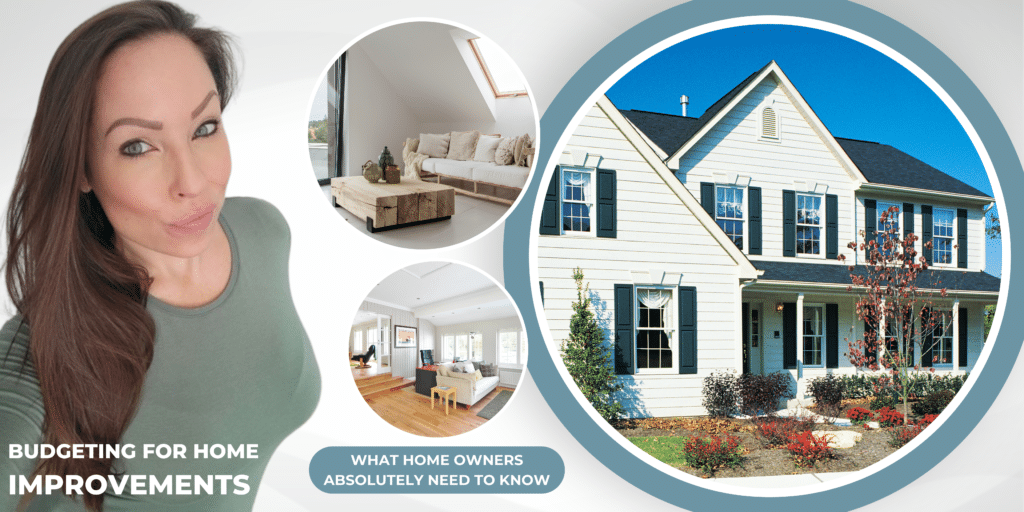
The Homeowner’s Ultimate Guide to Budgeting for Home Improvements: A Journey to a Better Home Without Breaking the Bank
Budgeting for home improvements! Whether you’re fueled by the desire to increase your property value, enhance your living space, or simply tackle some of those pesky maintenance issues, you’re now part of a narrative that homeowners know all too well. It’s like a rite of passage.
But here’s the snag—budgeting for these projects can be a labyrinth of uncertainty. Go too frugal and you risk quality; splurge recklessly and your bank account bears the brunt. But don’t worry, the middle ground does exist! Let’s navigate this challenging yet rewarding path together.
BUDGETING FOR HOME IMPROVEMENTS
Know What You Want and Why
Your ‘why’ can dramatically affect your budget. Do you need to fix a leaky roof, or are you planning to turn your basement into a man-cave or a chic home office? Understand that essential repairs and aesthetic improvements come with different price tags and ROI (Return on Investment) values. Know your priorities first; the budget will follow.
BUDGETING FOR HOME IMPROVEMENTS
Classify and Quantify: The Project List
Once your goals are clear, the next step is creating a comprehensive list of projects. Break them down into:
Essential Repairs: Leaky faucets, damaged flooring, electrical issues.
Functional Upgrades: Energy-efficient appliances, enhanced security systems.
Cosmetic Enhancements: Painting, landscaping, new furniture.
Attach tentative costs to each. Remember, this is an approximation—your best-educated guess—based on online research, friends’ experiences, or preliminary talks with contractors.
BUDGETING FOR HOME IMPROVEMENTS
Do the Math: Income, Savings, and Expenditures
You can’t set a budget without knowing what you can afford. Put down those home decor catalogs and do some financial soul-searching:
Income: What’s your monthly income post-tax?
Fixed Expenditures: Subtract your regular expenses—groceries, utilities, loan payments.
Savings: Definitely, don’t dip into your emergency funds. What’s left after you allocate for regular savings?
Discretionary Income: This is what you can potentially allocate for your home improvements.
BUDGETING FOR HOME IMPROVEMENTS
Financing: When Your Pocket Isn’t Deep Enough
If your discretionary income doesn’t cover the estimated project costs, you may need external financing. Here are options to consider:
- Personal Savings: Obviously the best option, but not always feasible.
- Home Equity Line of Credit (HELOC): A good option if you’ve built up significant equity in your home.
- Personal Loans: Quick and usually don’t require collateral, but interest rates can be high.
- Credit Cards: Convenient but risky due to high-interest rates. Use only for small, short-term projects you can pay off quickly.
BUDGETING FOR HOME IMPROVEMENTS
Quotes and Contractors: The Real Picture
Gather quotes from multiple contractors for a clearer idea of project costs. Each quote should include labor, materials, potential overages, and any subcontractor fees. Validate the contractors’ credentials and read reviews. When you get a gut feeling about a contractor who fits your needs and budget, that’s when you know you’ve struck gold!
Budget Padding: The Safety Net
No matter how meticulous you are, unexpected costs will crop up. The weather delays your deck completion, or the wallpaper you chose is out of stock and the alternative is more expensive. This is why you need a budget padding—typically 10-20% of the overall budget to cover unforeseen expenses.
Cost-Cutting vs Value-Adding: Striking a Balance
Sure, DIYing some tasks or choosing less expensive materials can save you a buck, but don’t compromise on aspects that add long-term value to your home. That granite countertop in the kitchen or the hardwood floor in the living room can boost your home’s resale value substantially.
Milestones and Payment Plans: Keep Track
It’s advisable to set milestones for project completion. Link payments to these milestones. Never pay the full amount upfront. Also, keep all invoices and transaction records; you’ll need them for warranty claims, or even tax deductions if the improvement is energy-efficient.
The Review Loop: Keep Calibrating
Treat your budget as a living, breathing entity. Regularly review it and adjust for any discrepancies between planned and actual costs. Budgeting isn’t a “set it and forget it” deal; it’s ongoing until the project is completed.
In Conclusion: It’s More Than Just Numbers! Budgeting for home improvements is a blend of art and science, intuition and logic. It’s about making informed decisions that not only enhance your living space but also contribute positively to your life’s bigger financial picture. This journey, while fraught with challenges, offers the profound satisfaction of seeing your dream home come to life, one improvement at a time.
So, dive into this exciting venture with confidence, bolstered by a budget plan that’s been crafted with care, diligence, and a dash of savvy for home owners!
For plenty of other great tips, make sure we’re connected on social @serenaholmesrealtor and you’ve subscribed to my YouTube Channel.
And of course, if you’re looking to buy, sell or invest in Durham Region or east Toronto, I can be reached at 647.896.6584, by email at info@serenaholmesrealtor.com or by filling out this contact form.
Sources:
Canada Mortgage and Housing Corporation: Renovation and Home Purchase Report
Various contractor websites for quote estimation
Personal Finance Canada: Financing Home Improvements
HomeStars Reviews: Authentic reviews of contractors and home services









